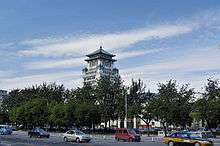Chang'an Avenue



Chang'an Avenue (simplified Chinese: 长安街; traditional Chinese: 長安街; pinyin: Cháng'ān Jiē), literally "Eternal Peace Street", is a major thoroughfare in Beijing, China.
It is often referred to as the Shili Changjie (simplified Chinese: 十里长街; traditional Chinese: 十里長街; pinyin: Shílǐ Chǎngjiē), meaning the Long Street of Ten Li. Chang'an is the old name for Xi'an which was the capital of China during the Tang Dynasty and other periods.
Strictly speaking, Chang'an Avenue only encompasses West Chang'an Avenue and East Chang'an Avenue. However, it is also used to refer to the stretch from Fuxingmen on the Western 2nd Ring Road to Jianguomen on the Eastern 2nd Ring Road.
In very broad terms, it refers to the stretch of road (the Extended Chang'an Avenue) as the route from Shijingshan District through to Tongzhou District, including portions of the Jingtong Expressway.
This article, and related articles, consider it to be the road from Fuxing Road through to the beginning of the Jingtong Expressway (E. 5th Ring Road). Others have defined it as the road from Shijingshan Road through to Dawangqiao on Jianguo Road.
In 2009 the road was widened to 10 lanes, as part of the 60th anniversary of the founding of the People's Republic of China.[1]
History
The East and West Chang'an Streets were built as part of the Imperial City of Beijing. East Chang'an Street originally ran from the Left Chang'an Gate (on the east side of the square before Tian'anmen gate) to the Dongdan gate, and West Chang'an Street originally ran from the Right Chang'an Gate (on the west side of the same square) to the Xidan gate. The north side of the square, between the two Chang'an Gates, became a road after 1912 and was named "Zhongshan Road", after Sun Yat-sen. In 1940, the Inner City wall was breached at Jianguomen and Fuxingmen respectively, due east and west of the ends of the East and West Chang'an Street. Streets extending from the ends of the two Chang'an Streets were widened to become Jianguomen Inner and Outer Streets and Fuxingmen Inner and Outer Streets. The two Chang'an Streets thus became part of a major thoroughfare into and out of the Inner City, now considered the "extended" Chang'an Avenue. The two Chang'an Gates were demolished in 1952 to expand Tiananmen Square, after which the two Chang'an Streets and Zhongshan Road were joined together and became known as "Chang'an Avenue".
Significance
Chang'an Avenue is the road directly before Tian'anmen gate and to the north of Tian'anmen Square. Because of its location, Chang'an Avenue has been associated with a number of important events in Chinese history, such as the Tian'anmen Square protests of 1989 (including the famous confrontation of the Tank Man), the May 4th Movement and the funeral procession of Zhou Enlai. During important celebrations in the People's Republic of China, military parades are conducted on Chang'an Avenue, with the procession travelling from East to West along the avenue, passing before Tiananmen gate.
Located along Chang'an Avenue and near Tian'anmen Square are the Great Hall of the People, Zhongnanhai, and central government buildings. The National Museum of China, National Centre for the Performing Arts, Wangfujing, Beijing Concert Hall and the headquarters of the central bank of China, the People's Bank of China are also on Chang'an Avenue. Both the Beijing railway station and Beijing west railway station are both located near Chang'an Avenue. Line 1 of the Beijing Subway runs under Chang'an Avenue.[2]
Because of its sensitive location, special regulations apply to Chang'an Avenue. For example, trucks and freight vehicles are banned day and night,[3] and no commercial advertising is allowed on the street.[4]
Sections
Note: This article considers Chang'an Avenue as the major through road from the W. 5th Ring Road through to the E. 5th Ring Road, which defines larger urban Beijing.
See also
References
- ↑ Beijing completes face-lift of main avenue for National Day. Xinhua. August 25, 2009.
- ↑ Welch, Patricia Bjaaland (2008). Chinese art: a guide to motifs and visual imagery. Tuttle Publishing. p. 270.
- ↑ The Current Major Traffic Management Measures of Urban Roads Archived July 23, 2011, at the Wayback Machine.. Beijing Traffic Management Bureau. May 15, 2009.
- ↑ Beijing Bans Commercial Ads on Tian'anmen Square, Chang'an Avenue. Xinhua. March 27, 2006.
External links
-
 Media related to Chang'an Avenue at Wikimedia Commons
Media related to Chang'an Avenue at Wikimedia Commons
Coordinates: 22°27′06″N 113°09′43″E / 22.4518°N 113.1619°E
